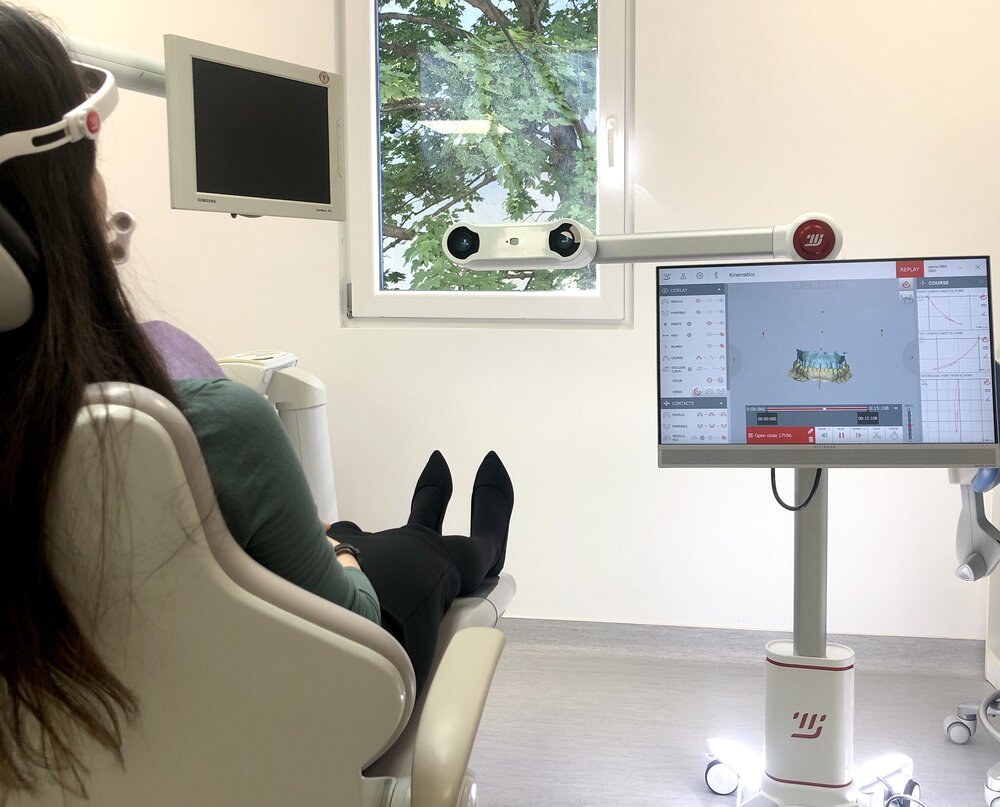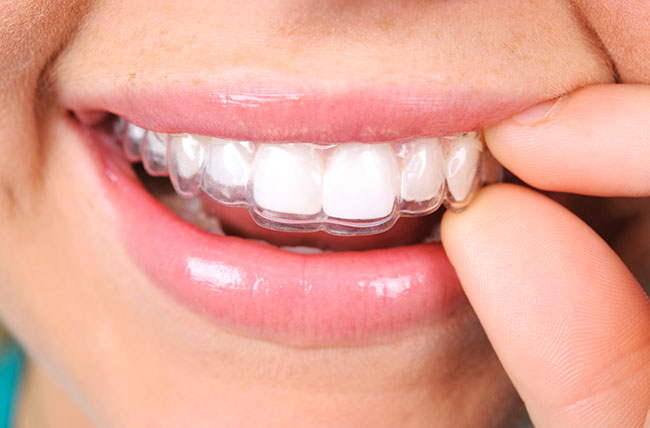Perfectly personalized dental restoration – Flexible implementation process – Using the latest tools
Dentists: Dr. Zoltán Óvári; Dr. Vivien Farkas; Dr. Mónika Ecsegi
What is 4D Aesthetic Smile Design?
Aesthetic smile design enables us to shape the teeth into a form that best complements the individual’s personality and face. his ensures that the overall appearance of the face remains harmonious and well-arranged during speech, laughter, and smiling.


In addition to simple methods of assessing crucial aesthetic parameters such as width/length ratio, visibility of the dental arch, and evenness of the gum line, as well as examining the harmony between the face, eyes, and teeth, highly sophisticated computer programs assist in aesthetic planning. In our practice, we use the Digital Smile Design (DSD) program developed in Brazil for aesthetic planning.
Teeth are essential elements of facial aesthetics, but they also play a very important functional role. Poor alignment or interferences between teeth during jaw movement can lead to further damage to the teeth, the temporomandibular joint, or even other areas of the body. Insufficient chewing can also cause additional general medical problems. Therefore, precise planning of tooth position and jaw movement is very important- this is the fourth dimension, for which our practice has been using a unique method and several years of experience. For 4D planning, we use the Modjaw device in our practice.

Why is Aesthetic Smile Design Beneficial for You?
Thanks to thorough planning and state-of-the-art technology, patients are not presented with a ready-made, unchangeable, or minimally modifiable dental restoration; instead, they actively participate in the process during planning.
Careful consideration of possibilities in aesthetic dentistry allows for modeling the expected outcome even before the treatment begins. The digitally designed visual representation, approved by the patients, can be viewed in the mouth before the actual work starts. Treatment on the teeth only begins after achieving the desired visual design.
4D aesthetic smile design is a minimally invasive treatment, meaning that, thanks to precise modeling, only the necessary amount of tooth material is reduced, resulting in minimal sacrifice of dental structure.

Treatment Process:
Below, we describe a typical treatment process, but since each patient has different characteristics, it may vary in individual cases. Therefore, every treatment is only invoiced after a thorough assessment, planning, consultation with the patient, and their approval.
Step 1:
We take photos of the dental arch and smile.
Step 2:
We create a model of the teeth (either through traditional impressions or intraoral scanning).
Step 3:
If changes in the bite position or temporomandibular joint issues need to be addressed, we digitally model the jaw movement using the Modjaw device.
Step 4:
After bite analysis with the Modjaw computer program, we set the desired position of the jaws, and the aesthetic smile design begins.
Step 5:
The new shape of the teeth is designed through either free or guided computer planning (visible to the patient, adjustable, and fine-tunable upon request).
Step 6:
This is followed by a real-life trial, where the solution modeled on the screen is tried on the original teeth using a temporary material (changes can still be made at this stage).
Step 7:
After the trial, tooth preparation begins (thanks to precise planning, this involves minimal loss of tooth structure).
Step 8:
Traditional or digital impressions are taken of the prepared teeth.
Step 9:
The planned teeth are carved, and the aesthetic material is customized (coloring) by the dental technician on-site, adjusting the shade until it perfectly matches the patient’s facial harmony.
Step 10:
If necessary, gum correction is performed.
Step 11:
After complete preparation, the final teeth are bonded into the mouth, and an impression is taken for a night guard. This is necessary during the first year to allow the chewing apparatus to adapt to the new teeth and prevent unintentional damage caused by nocturnal movements
Take care of your teeth!
Do you have a question? Write to us!
Articles on the topic
Our Patients Said
“For a while, I struggled a lot with my teeth, experiencing significant pain. However, a huge change happened after visiting CosmoDent. They solved my problems quickly, precisely, and painlessly! Professional team!”
Dóri
In the last two weeks, my wife and I visited you several times for check-ups, cleanings, and each of us had a filling done by Dr. Vivien Farkas or Márta Nagy. We would like to give feedback that we were very satisfied with the treatment. We are grateful for the helpful advice. The atmosphere at your clinic was very pleasant. It was great to experience how well you cared for us, without overdoing it. Although we don’t usually stress about going to the dentist, I noticed that the last time we went to you, we were completely relaxed, which I think is very cool considering that many people don’t like going to the dentist. We wish you continue to provide your service so beautifully!
Young Budapest Family
“I have been very satisfied with the services of Cosmodent for 16 years now. Extremely knowledgeable doctor team, modern technology, kind service, attention to detail.
I highly recommend the Team after numerous dental interventions.”
Réka
“The equipment and knowledge are unique at the clinic. I have been to many places, but I have never experienced such care! I came home with a bigger smile than I arrived with! Thank you!”
Ágnes
“It seemed like all my teeth had to be pulled out. However, after a thorough examination, it turned out that most of my teeth could be saved. The whole team, especially my dentist, Dr. Peter Rosta, made a great effort and did a fantastic job. I am already full of positive expectations for the next stage of my treatment, when I will get the implants. I really hope that after the complete treatment, I will have an aesthetic and, above all, functional set of teeth again.
I can only recommend the team at Cosmodent to everyone!”
Thomas
“I received the most thorough, attentive treatment at the dental clinic. I am completely satisfied. I will choose CosmoDent again for the next time!”
Erzsébet
“I really liked the new dental office. The new environment is very nice, the design of the dentistry gives the impression that one is in good hands. The employees there are very sympathetic, kind, and attentive. The hygiene is impeccable, which is a very important factor for dentistry even in this Covid situation. Overall, I recommend it to anyone who hesitates where to go.”
Aliz
“I have been to Cosmodent Dentistry for tartar removal treatment several times, performed by Éva Kriston. The treatment was thorough and painless, and Éva was kind and answered all my questions willingly. I will choose Cosmodent in the future as well.”
Kriszti
We apply various treatments thoughtfully, so that we find the right one for everyone
- Through a thorough examination, we establish an accurate diagnosis
- In consultation with you, we will put together the complete treatment plan
- Diagnostics, specialists, and dental technology all in one place


